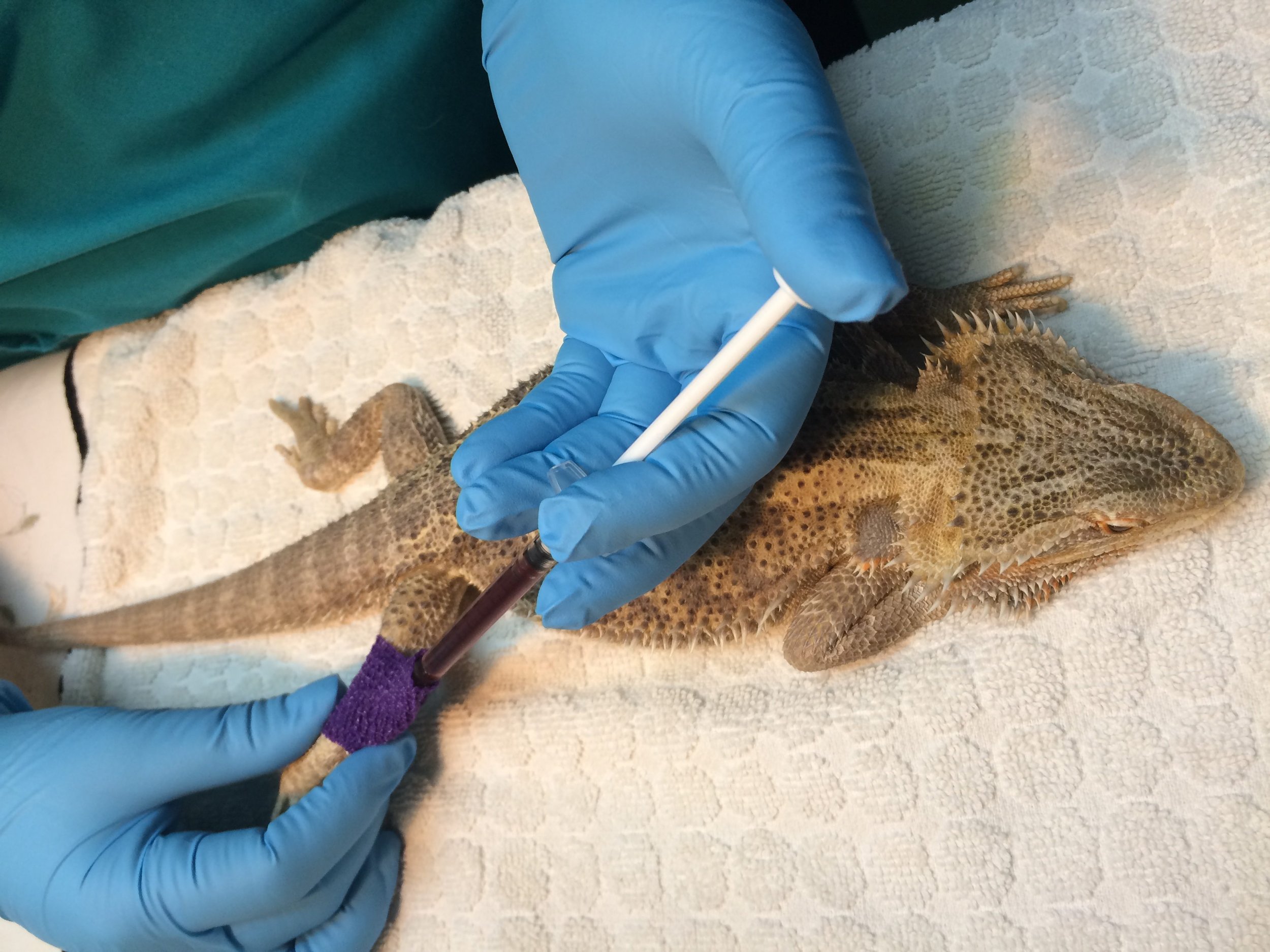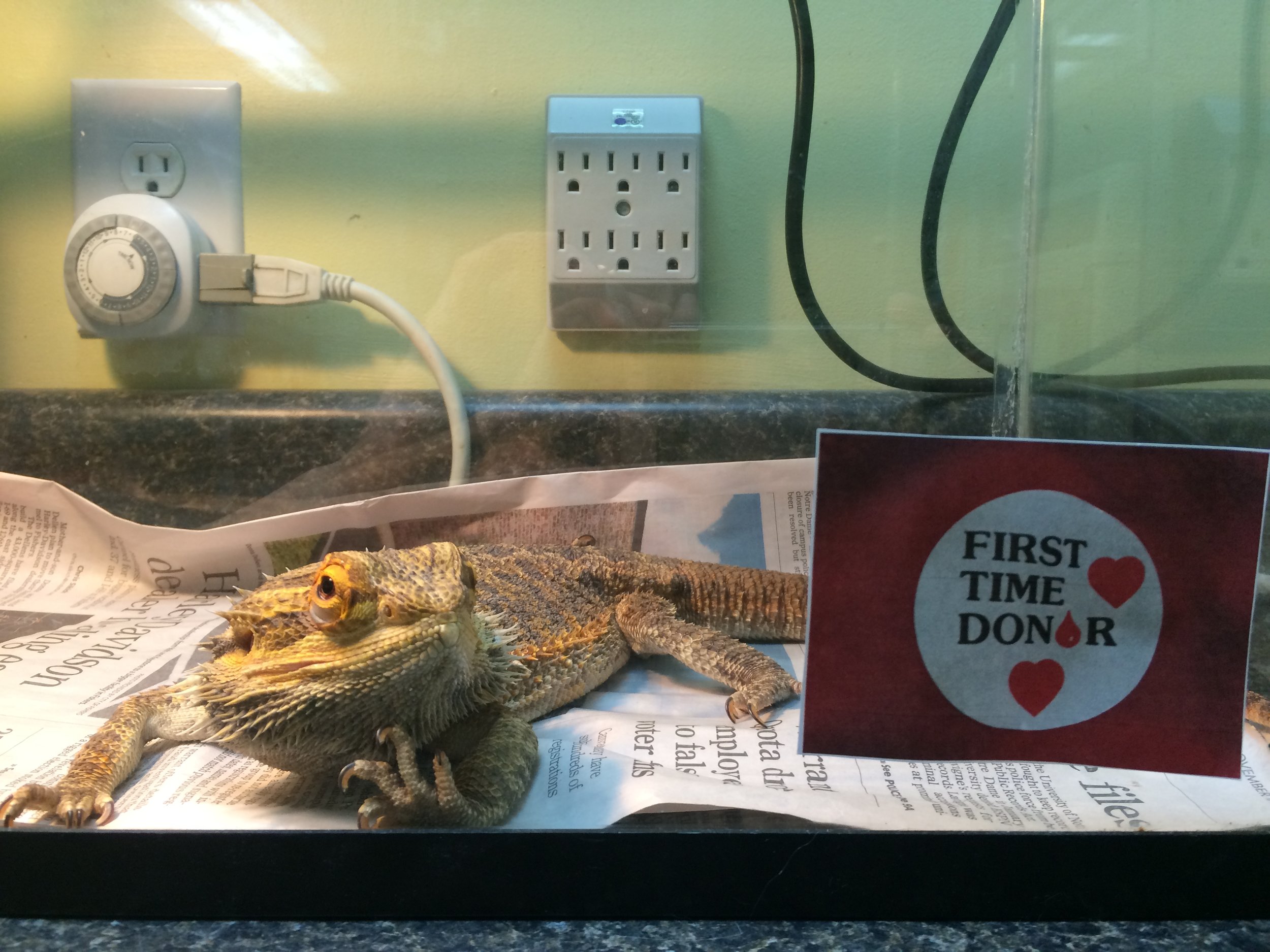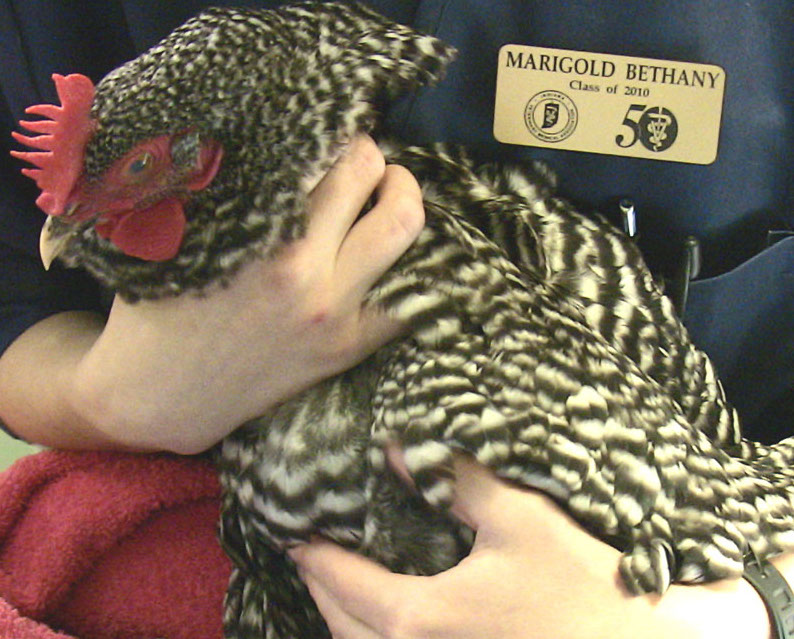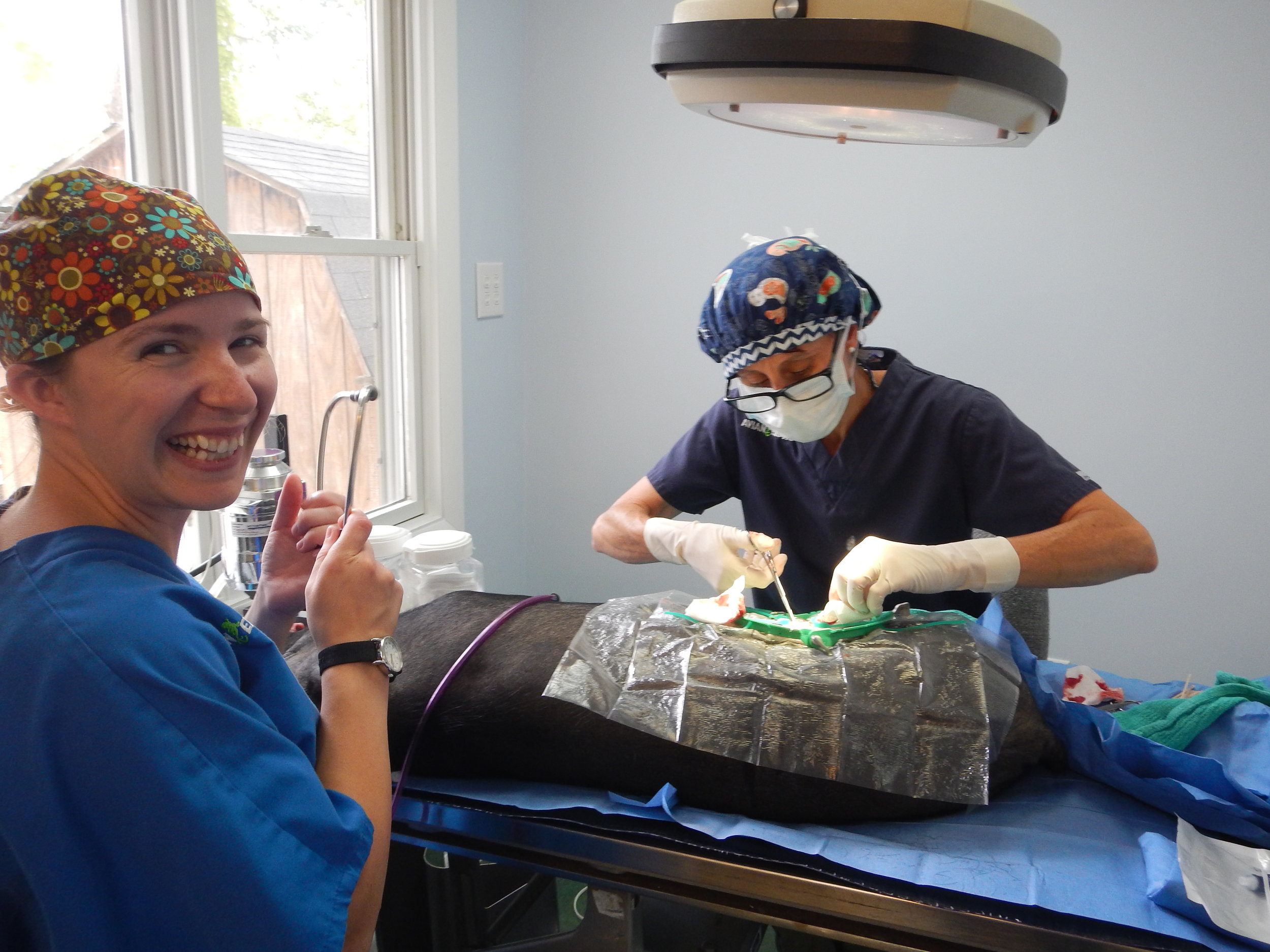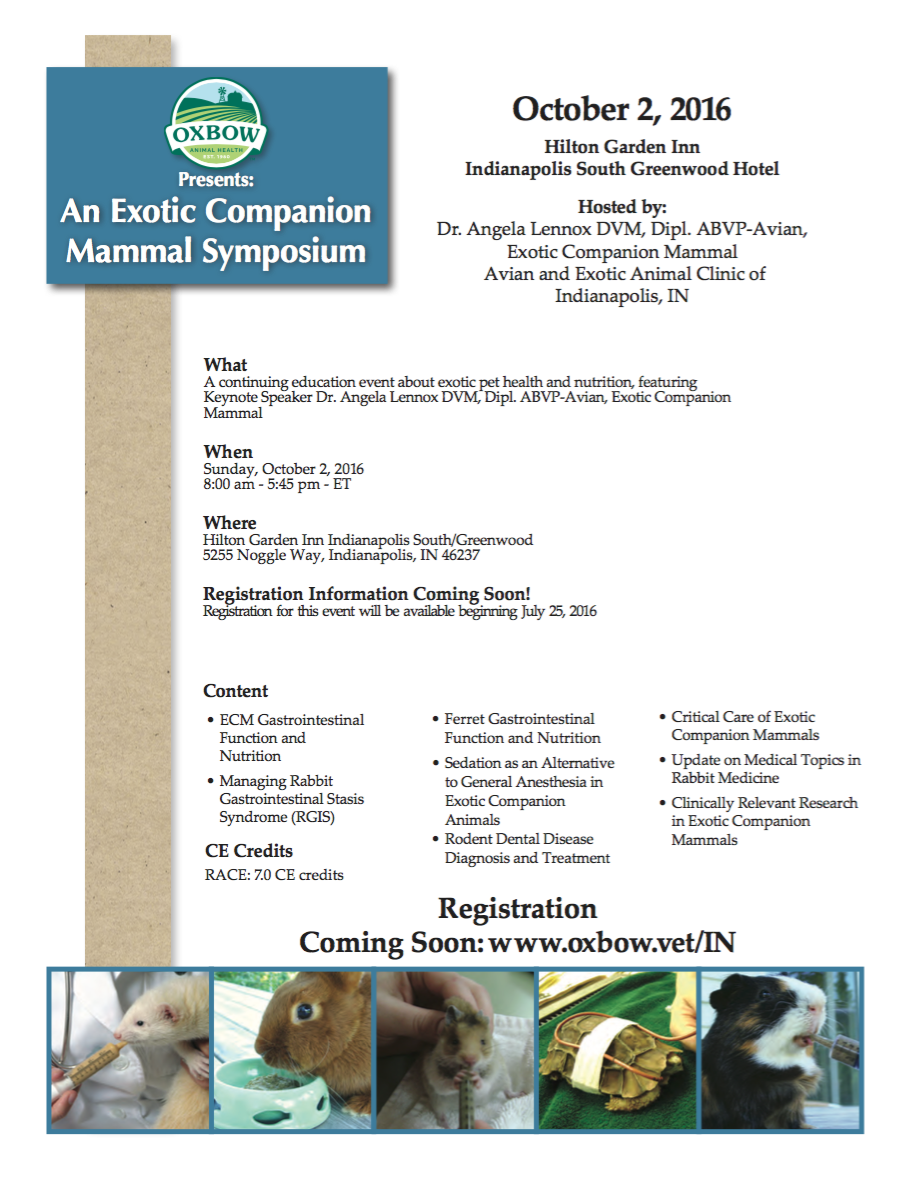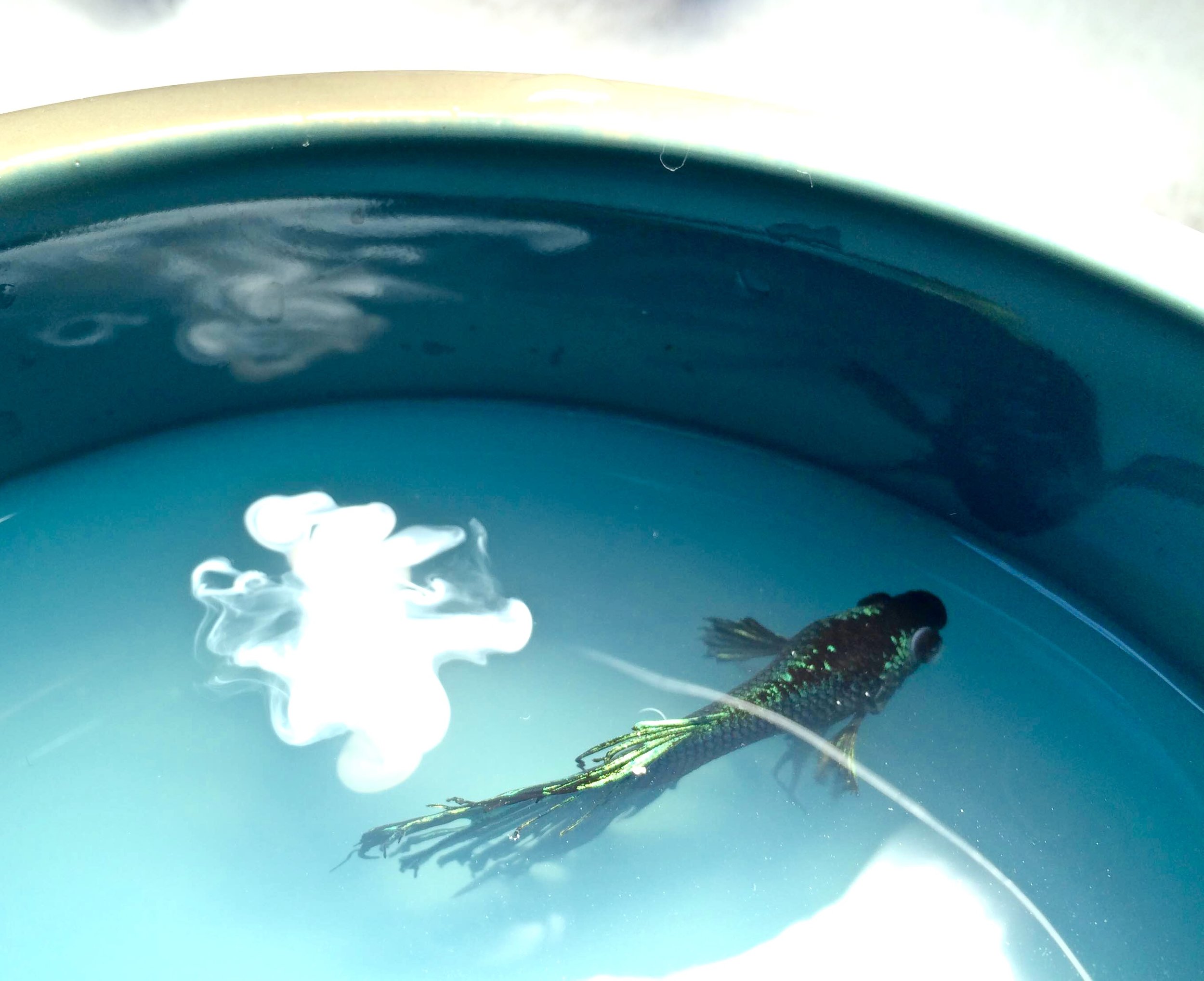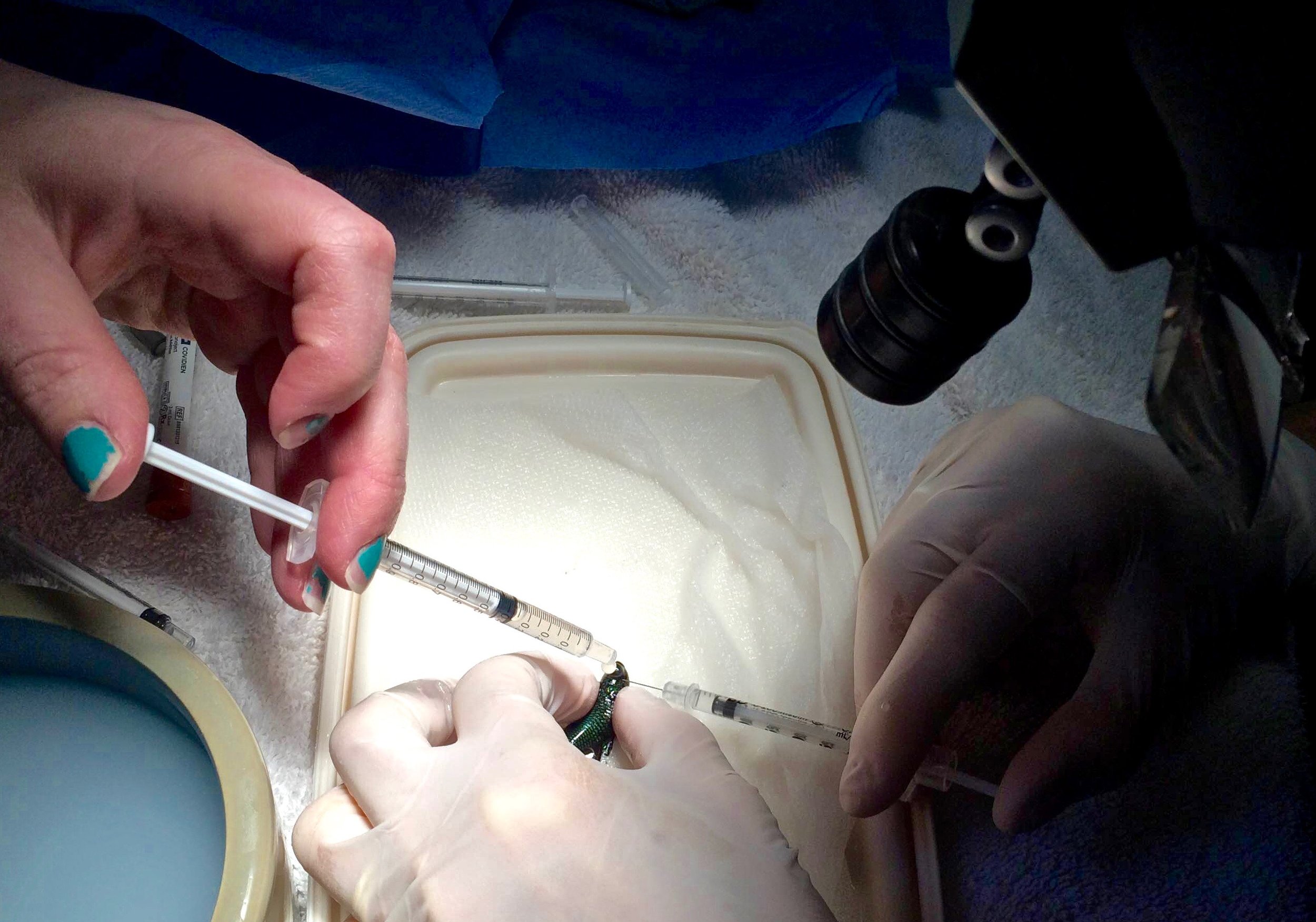Highlights from NAVC 2017
Dr. Swisher attended the exotics session at the North American Veterinary Conference in February, 2017. Here are some highlights from the Exotic Companion Mammal (ECM) sessions: a) Endocrinology: Some endocrine diseases have long been recognized in ECM, including adrenal disease and insulinoma in ferrets, cystic ovaries in guinea pigs, pituitary adenomas in rats, and diabetes mellitus in hamsters and degus. However, in recent years, there has been increasing recognition of other, less common endocrine diseases, including hyperthyroidism in guinea pigs and rabbits, Cushing's disease in hamsters, adrenal disease in rabbits, and disorders of the pancreas (DM or insulinoma) in many species. b) Idiopathic hematuria in guinea pigs: While hematuria in guinea pigs is typically attributed to urinary tract infection or urolithiasis, there is increasing evidence that guinea pigs may also develop sterile cystitis of unknown etiology. This emphasizes the importance of performing appropriate diagnostics, including urinalysis, urine culture, and imaging. Note that previous studies have demonstrated that almost all free catch samples from guinea pigs are contaminated with bacteria, so this is not an appropriate technique for diagnosis of UTI. Some guinea pigs with sterile cystitis may respond to NSAID therapy and husbandry changes to increase water consumption.
Liver Lobe Torsion in Rabbits
A 3-year-old female rabbit presented for vague signs (decreased appetite and stool, less active), and physical examination findings (mild abdominal discomfort upon palpation) consistent with Rabbit Gastrointestinal Syndrome (RGIS). What is your next diagnostic or treatment step? Many underlying disease conditions can cause this clinical presentation, some mild, and some potentially catastrophic, e.g. GI foreign body obstruction.
For this reason, rabbits presenting with RGIS should ideally undergo a diagnostic work up, including abdominal radiographs and a biochemistry panel. Dr Jennifer Graham’s excellent article (below) found that the overwhelming majority of rabbits with liver lobe torsion had a similar presentation, but showed an elevation in liver enzymes; in each case, diagnosis was confirmed by use of hepatic ultrasound with Doppler assessment. Rapid surgical intervention and liver lobectomy was curative.
Read more here.
Journal of Exotic Pet Medicine 23(3); 2014.
Liver Lobe Torsion in Rabbits: 16 Cases (2007 to 2012)
Jennifer E. Graham,DVM, Dip. ABVP (Avian; Exotic Companion Mammal), Dip. ACZM; Connie J. Orcutt,DVM, Dip. ABVP (Avian; Exotic Companion Mammal); Sue A. Casale,DVM, Dip. ACVS; Patty J. Ewing,DVM, MS, Dip. ACVP; Jessica Basseches,DVM, Dip. ACVR
Meloxicam in Rabbits
Anesthetic and analgesic pharmacokinetic studies are continually helping us to revise our dosages and protocols for exotic species. A recent example is Meloxicam use in rabbits; while earlier formularies suggest a dosage of 0.2 mg/kg PO, a 2013 pharmacokinetic study suggested clinically useful dosages are likely much higher. See the following article for more information: Am J Vet Res. 2013 Apr;74(4):636-41 Pharmacokinetics of meloxicam in rabbits after oral administration of single and multiple doses. Fredholm DV1, Carpenter JW, KuKanich B, Kohles M.
Our current dosage recommendation for short-term use of Meloxicam in well-hydrated, normovolemic rabbits without evidence of renal dysfunction is 0.8-1.0 mg/kg PO. The authors of the study conclude:
"Plasma concentrations of meloxicam for rabbits in the present study were proportionally higher than those previously reported for rabbits receiving 0.2 mg of meloxicam/kg and were similar to those determined for animals of other species that received clinically effective doses. A dose of 1 mg/kg may be necessary to achieve clinically effective circulating concentrations of meloxicam in rabbits, although further studies are needed."
Outbreak of Seoul Virus in Rats
The Indiana State Department of Health alerted veterinarians and other health professionals about an outbreak of a virus that was found in pet rats sold and shipped from Illinois and Wisconsin after September 1, 2016.
The Seoul virus is related to hantavirus; while hantavirus can cause severe illness, the Seoul virus is much less severe.
The board of health is alerting owners who might have purchased rats from this facility.
If you have any questions about exposure to rats purchased from Illinois and Wisconsin after September 1, call the Indiana State Department of Health (ISDH) Epidemiology Resource Center at 317-233-7125.
More information about the Seoul virus can be found here: https://www.cdc.gov/hantavirus/outbreaks/seoul-virus/index.html.
The ISDH recommends the following preventive measures for all rodent owners:
- Wash your hands with soap and running water after touching, feeding, or caring for rodents or cleaning their habitats. Be sure to assist children with handwashing.
- Be aware that pet rodents can shed germs that can contaminate surfaces in areas where they live and roam. Make sure rodent enclosures are properly secured and safe so your pet doesn’t get hurt or contaminate surfaces.
- Clean and disinfect rodent habitats and supplies outside your home when possible. Never clean rodent habitats or their supplies in the kitchen sink, other food preparation areas, or the bathroom sink.
- Avoid bites and scratches from rodents. Be cautious with unfamiliar animals, even if they seem friendly. Take precautions when cleaning out rodent cages or areas with rodent urine or droppings.
- Visit your veterinarian for routine evaluation and care to keep your rodents healthy and to prevent infectious diseases.
Pet Chicken Day!
Bats and Rabies: The Risk Is REAL And Here In Central Indiana
 Last week the Avian and Exotic Animal Clinic took in a sick Brown bat found by a local family. The bat did not survive, and was sent to the Indiana State Department of Health for testing. Unfortunately the bat was positive for rabies virus. The family and everyone exposed to the bat will now need treatment for rabies exposure. This episode emphasizes the fact that while rare, rabies is present in Indiana and is a potential danger to anyone handling wildlife, especially bats, skunks, raccoons, and foxes. While AEAC will accept injured and orphaned wildlife, we urge the public to contact Animal Control or local law enforcement, and do not handle potential rabies carriers, especially bats.
“Bats are the most important rabies carriers in the state of Indiana,” said Dr. Jen Brown, State Public Health Veterinarian at the Indiana State Department of Health. “It is best not to handle live bats. Anyone who has had possible contact with a bat should call the local health department for advice on whether to receive rabies shots. If a possible exposure has occurred, then the bat should be safely collected so that it can be tested for rabies.”
Last week the Avian and Exotic Animal Clinic took in a sick Brown bat found by a local family. The bat did not survive, and was sent to the Indiana State Department of Health for testing. Unfortunately the bat was positive for rabies virus. The family and everyone exposed to the bat will now need treatment for rabies exposure. This episode emphasizes the fact that while rare, rabies is present in Indiana and is a potential danger to anyone handling wildlife, especially bats, skunks, raccoons, and foxes. While AEAC will accept injured and orphaned wildlife, we urge the public to contact Animal Control or local law enforcement, and do not handle potential rabies carriers, especially bats.
“Bats are the most important rabies carriers in the state of Indiana,” said Dr. Jen Brown, State Public Health Veterinarian at the Indiana State Department of Health. “It is best not to handle live bats. Anyone who has had possible contact with a bat should call the local health department for advice on whether to receive rabies shots. If a possible exposure has occurred, then the bat should be safely collected so that it can be tested for rabies.”
It's interesting to note that in the US, we are actually fortunate when it comes to rabies exposure. According to the World Health Organization, tens of thousands people die of rabies each year, mostly in Asia (especially India) and Africa. The victims are mostly children, and the source is overwhelmingly unvaccinated dogs. Routine vaccination of pets in the US is an amazing success story, and owners should be congratulated and encouraged to keep up our defenses against this terrible disease.
For more information on India's rabies crisis, go here: http://www.bbc.com/future/story/20150915-indias-rabid-dog-problem-is-running-the-country-ragged
Hello From the Hay Fields of Nebraska!
Small Pets 101 Seminar in Indy
Biennial Pet Bird Symposium at PVM
Want 9 Avian Medicine CE credit hours close to home? Join us for the Biennial Pet Bird Symposium November 13-14 at Purdue University. Featured topics include: “Commonly Kept Parrot Species and Their Characteristics,” “Update on Viral Diseases and Chlamydophila,” “Sedation, High Risk Anesthesia and Critical Care Management,” “Cloacal Prolapse Management,” “Dermatologic Conditions,” “The Geriatric Parrot,” and “Renal System Disorders.”
Speakers include Purdue Veterinary Medicine clinicians: Dr. Steve Thompson, clinical associate professor and director of the Pet Wellness Clinic, and Dr. Lorraine Corriveau, wellness clinician in the Small Animal Community Practice; as well as ABVP Board Certified Avian Specialist Dr. Angela Lennox, and Dr. Bianca Zaffarano, Iowa State University College of Veterinary Medicine faculty clinician.
In addition to lectures, the program will include a variety of case-based discussions. Topics are suitable for both veterinarians and veterinary technicians. Click here for more information, and to register.
Nine continuing education (CE) credits will be offered for this symposium.
Click here for more information.
Congratulations to Our Two Brand New Veterinary Technicians!
Avian and Exotic Animal Clinic is proud to announce Brie Worrell and Savannah Goins recently passed their qualifying exams and have graduated from Veterinary Assistant to Registered Veterinary Technician. They join Kasey Gardner who passed her exam in the spring.
So what’s the difference between veterinary assistant and technician?
A Veterinary Technician is a highly trained veterinary nurse qualified to assist with a number of important jobs, such as monitoring anesthesia and running diagnostic tests. It is these bright professionals who work hard to keep our patients safe during surgery.
Both Brie and Savannah spent time during their training learning with us, and joined our team right after finishing class work. Both passed the qualifying test together in August, and we are very proud of both of their efforts.
Are you or someone you know interested in a career as a veterinary technician? Here is advice from Brie and Savannah:
Advice to future vet techs:
Start getting experience with animals as early as possible! Volunteering or working as an assistant in a vet clinic are both great places to start. In order to become a Registered Veterinary Technician, you must graduate from an accredited veterinary technician school. This is a two year degree program, though some schools offer an accelerated 18 month program instead. Once you start the program, stick with it! And if possible continue working or volunteering in a vet clinic to continue increasing your experience. Once you've graduated with a degree in veterinary technology, you have to pass the Veterinary Technician National Exam as well as the state exam for which ever state you want to be registered in. That is the process in a nutshell. Good luck!
Graduation Ceremony at Avian and Exotic Animal Clinic
 Congratulations to Dr. Samantha Swisher, who this week completed her 2 year residency at the Avian and Exotic Animal Clinic. Dr. Swisher will now remain at AEAC as an associate veterinarian, and work towards completing her Exotic Companion Medicine Board Specialty.
Dr. Swisher was surprised to see that her "graduation" included robes, presentation of a wand, and a book entitled "Magic Animal Formulary".
Congratulations to Dr. Samantha Swisher, who this week completed her 2 year residency at the Avian and Exotic Animal Clinic. Dr. Swisher will now remain at AEAC as an associate veterinarian, and work towards completing her Exotic Companion Medicine Board Specialty.
Dr. Swisher was surprised to see that her "graduation" included robes, presentation of a wand, and a book entitled "Magic Animal Formulary".
Upcoming Exotic Animal Mini Conference in Indianapolis hosted by Oxbow Animal Health
Announcing construction of the latest addition to the Avian and Exotic Animal Clinic: The Avian and Exotic Inn!
 We are looking forward to the grand opening of our exotic animal only boarding facility this fall. Construction began in mid June, and we see more progress every day.
We are looking forward to the grand opening of our exotic animal only boarding facility this fall. Construction began in mid June, and we see more progress every day.
The demand for exotic pet boarding and baby-sitting is increasing, and many dog and cat boarding facility won't care for unusual pets. This new addition will allow plenty of room, and separate facilities for exotic mammals, birds and reptiles.
We don't have an opening date just yet, but anticipate late summer/early fall.
Highlights from April Journal of Exotic Pet Medicine
The Journal of Exotic Pet Medicine (JEPM) is an outstanding resource for exotic practitioners with peer reviewed case reports clinical briefs, research and more; species include birds, exotic mammals, reptiles and even fish. The next few e-messages we will summarize highlights from that issue. Sedation and Local Anesthesia as an Alternative to General Anesthesia in Three Birds
Lee A, Lennox AM.
 This article featured 3 cases of the use of midazolam and butorphanol combined with lidocaine for treatment of a dermal cyst, amputation of a digit and repair of predator wounds in a conure, cockatiel and pet chicken. Sedation plus local were effective and safe. Sedation should be considered any time general anesthesia is not absolutely indicated.
This article featured 3 cases of the use of midazolam and butorphanol combined with lidocaine for treatment of a dermal cyst, amputation of a digit and repair of predator wounds in a conure, cockatiel and pet chicken. Sedation plus local were effective and safe. Sedation should be considered any time general anesthesia is not absolutely indicated.
Abnormal Buoyancy in a Convict Cichlid Associated with an Ovarian Carcinoma Invading the Swim Bladder.
Lewis S, Pinkerton M, Churgin S, Slaky K.
Buoyancy problems are common in fish, and there are multiple etiologies. This case report demonstrated invasion of ovarian carcinoma into the swim bladder as a cause of lateral recumbency. Diagnosis of buoyancy disorders requires a thorough approach in order to formulate a possible treatment plan.
Visiting Campers
On Wednesday, we welcomed a large group of campers from our neighborhood to come have a tour and meet some exotic pets. Eighteen kids from St. Joseph’s Institte for the Deaf, which is located right down the street from us, walked down for a visit. The children took a tour, petted a turtle and a rabbit, and met Abba and Happy the Caiques. Special thanks to EARPS for providing such a patient and quiet bunny for the children to meet!
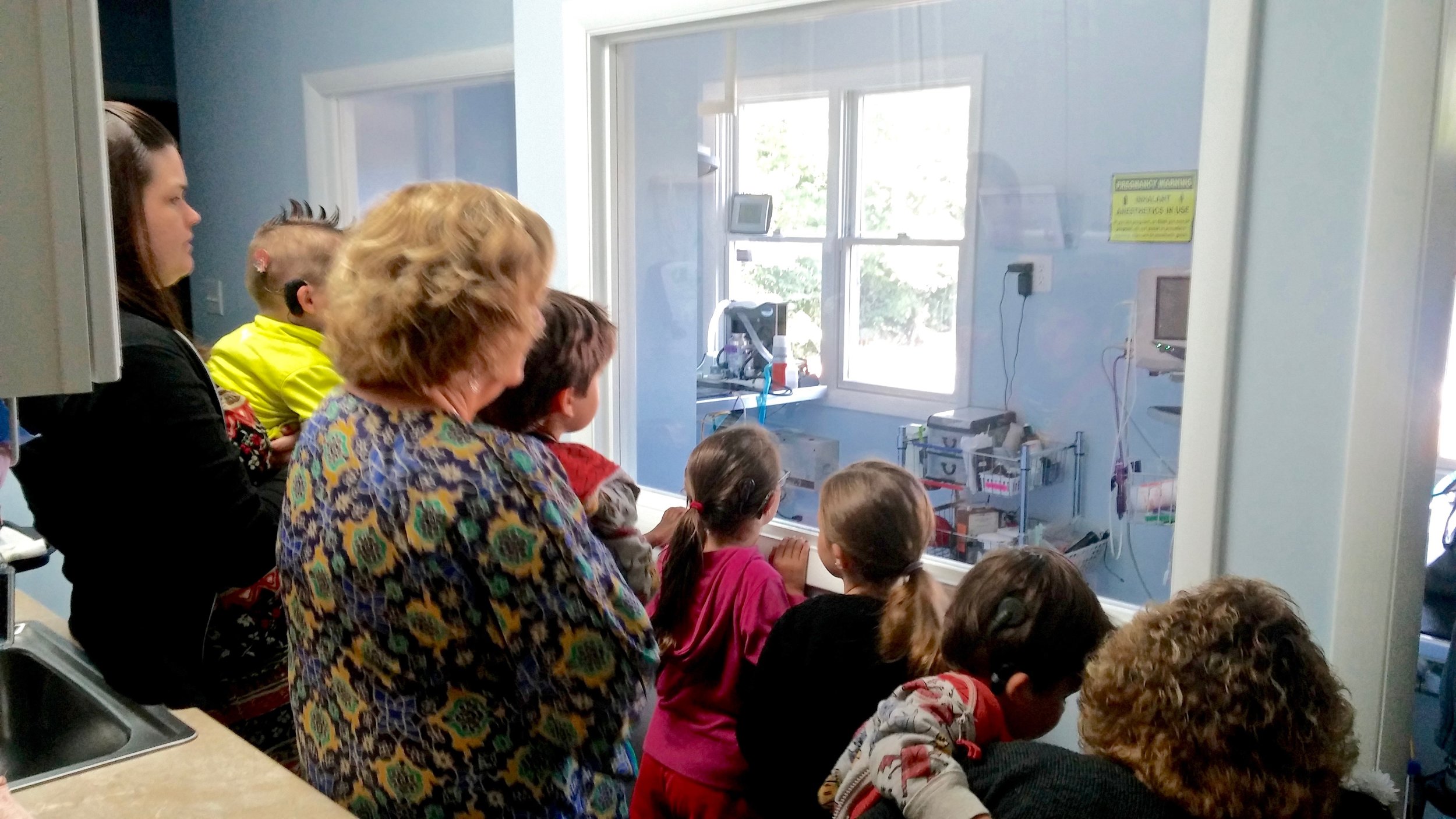
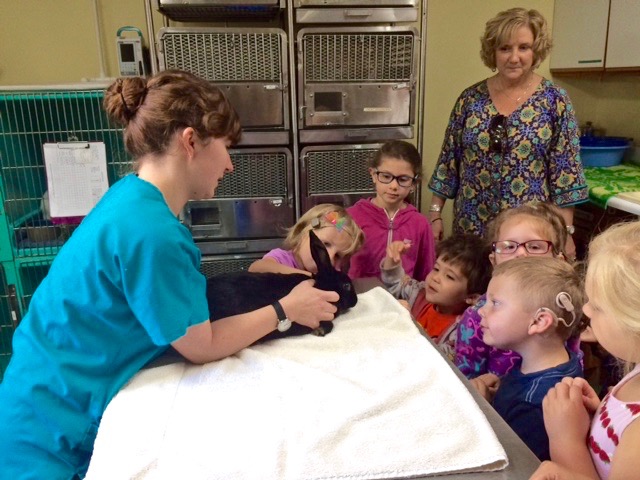

Dr. Lennox Goes to Poland
 Dr. Lennox recently returned from a visit to Poland, to teach at the VetForum conference in the city of Lodz. It's always fun to meet colleagues from around the world, and see how exotic animal medicine is different, and in many ways just the same. In Poland exotic pets are increasing in popularity, and more people are bringing them to the veterinarian for care. My host Dr. Agnieszka Drohobycka had time to show me some interesting sites in Krakow. Perhaps the most interesting was the wonderful "log cabin" she and her husband are restoring. It was great to stay with them, and walk to the local bakery for bread and the neighbor's cow for fresh milk!
Dr. Lennox recently returned from a visit to Poland, to teach at the VetForum conference in the city of Lodz. It's always fun to meet colleagues from around the world, and see how exotic animal medicine is different, and in many ways just the same. In Poland exotic pets are increasing in popularity, and more people are bringing them to the veterinarian for care. My host Dr. Agnieszka Drohobycka had time to show me some interesting sites in Krakow. Perhaps the most interesting was the wonderful "log cabin" she and her husband are restoring. It was great to stay with them, and walk to the local bakery for bread and the neighbor's cow for fresh milk!
Case Study: Spike the Betta Fish
Spike the betta fish developed an abnormality of his right eye. The eye could not be repaired, and so his owner elected to have us remove it. Eye problems like these are potentially painful in other species, so we assumed it would be the same for Spike.
**WARNING: Surgery Pictures Below!**
Spike came in for his post surgical recheck last week and his owner reports he is doing well. He is one lucky betta!
Did you know there is an organization dedicated just to medicine and surgery of fish? The American Association of Fish Veterinarians even holds their own annual conferences. Learn more at: http://www.fishvets.org
RACE Approved Exotic Companion Mammal CE Coming to Indianapolis
 Oxbow Animal Health provides reasonably priced, single day exotic mammal CE several times per year all over the US. In October, an Oxbow Exotic Companion Mammal Symposium is coming to Indianapolis. The October Symposium features Dr. Angela Lennox, Dr. Micah Kohles and Dr. Vladmir Jekyl, and will cover rabbit and rodent dentistry, GI disease and more.
More details will be available soon: http://www.oxbowanimalhealth.com/vets/exotic_symposium
Oxbow Animal Health provides reasonably priced, single day exotic mammal CE several times per year all over the US. In October, an Oxbow Exotic Companion Mammal Symposium is coming to Indianapolis. The October Symposium features Dr. Angela Lennox, Dr. Micah Kohles and Dr. Vladmir Jekyl, and will cover rabbit and rodent dentistry, GI disease and more.
More details will be available soon: http://www.oxbowanimalhealth.com/vets/exotic_symposium
Veterinary Technician vs. Veterinary Nurse?
What should we calls the licensed professionals who assist the veterinarian?
 "Technician" is the traditional term in the United States; however, there is a move to change that designation to "Nurse", which many believe more accurately describes the role of these well trained and compassionate professionals, and is in alignment with much of the rest of world, and with human medicine.
"Technician" is the traditional term in the United States; however, there is a move to change that designation to "Nurse", which many believe more accurately describes the role of these well trained and compassionate professionals, and is in alignment with much of the rest of world, and with human medicine.
The North American Veterinary Technician's Association is pushing to make the change official. Some of the reasons cited are that "technician" sounds too mechanical, like a professional that works with machines or cars.
See more information on the debate here; http://www.navta.net/page/Vet_Techs_In_Action
What do you think about the name change? Do you support or oppose an official name change from Veterinary Technician to Veterinary Nurse? Let us know what you think on our Facebook!



